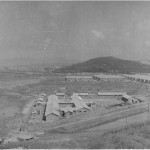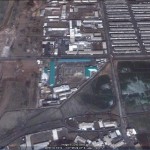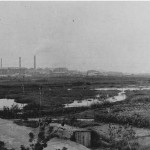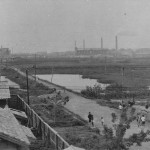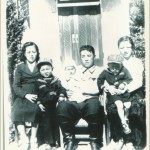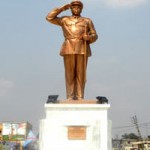According to the Choson Ilbo:
Academics from North Korea and Japan have unearthed a large tumulus from the Koguryo period in Pyongyang, providing valuable material for studying the history of ancient East Asia, Japan’s Kyodo news agency said Saturday. About 4.5 km away from the downtown Pyongyang, the tomb was discovered during construction work in Tongsan-dong, the Lelang District of the Koguryo era and is presumed to have been created around the 5th century.
According to the news agency, the mural paintings in the tomb show a man in horn-shaped headgear on horseback, a procession of men holding flags on armored horses, and warriors with swords. The antechamber and main chamber at the back are connected with a narrow passage, while the bones of a man and two women have been found in the back chamber. The tomb has some unique features, including the antechamber’s arched ceilings with three layers of triangular props and the mound created by piling up alternate layers of lime, charcoal and red clay to cover the stone chambers beneath, the report said. The mound is 35 m in diameter and 8 m high.
Pyongyang plans to register the tomb with UNESCO as a World Heritage site. Japanese scholars said the tomb’s murals are comparable to those of Tokhung-ri Tomb in Nampo, South Pyongan Province, which is included in the Complex of Koguryo Tombs inscribed in the World Heritage List in 2004.
The team also found relics offering a glimpse of how sophisticated Koguryo culture was, such as gold and silver ornaments, tiger-shaped pottery, bronze coins and nails for coffins. The celadon candlestick is the first of its kind to be excavated in the North, the report added.
The team consists of researchers with the Archaeological Institute of the North’s Academy of Social Sciences and Japanese scholars sent by Kyoto news agency including Prof. Masahiro Saotome, an archaeologist at the University of Tokyo, and Shigeo Aoki, a Cyber University professor specializing in the preservation of historic remains. Saotome said the tomb “was unearthed in an area where experts believed there would be no Koguryo mural tombs.”
Ahn Hwi-joon, a Korean art historian and professor emeritus at Seoul National University, echoed him saying, “It is the first time that Koguryo tomb murals have been unearthed in the area once controlled by the Chinese Han Dynasty Commander of Lelang. They are especially valuable as they were executed in the late fourth to the fifth centuries, immediately after Koguryo incorporated Lelang.”
Read the full story here:
N.Korean-Japanese Team Finds Koguryo Tomb in Pyongyang
Choson Ilbo
8/16/2010

